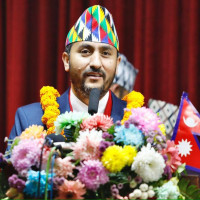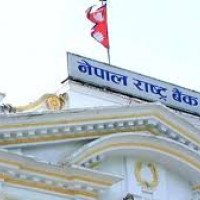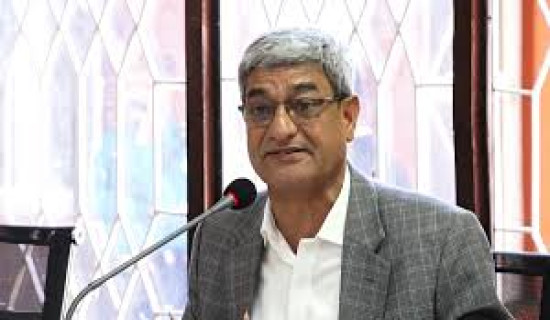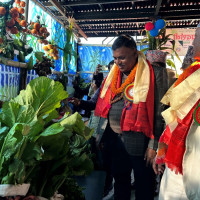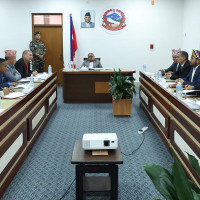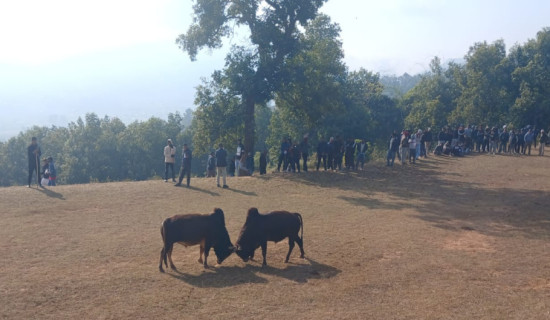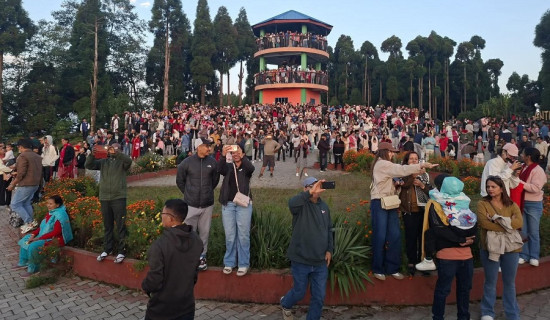- Friday, 2 January 2026
We've arranged free education in Community Campus
Miklajung Rural Municipality in northeastern Morang has a unique geography spanning from the plains where Sal trees grow to the highlands where Rhododendrons blossom. It was formed by amalgamating the entire erstwhile Ramite Khola and Tandi village development committees, and six wards of Madhumalla Village Development Committee and two of Jante Village Development Committee. This rural municipality has the highest internal revenue in Morang district with agriculture, tourism and natural resources being the primary sources of income. Our Correspondent Hari Prasad Koirala recently talked to rural municipality chairman Babi Kumar Rai on various issues of development. Excerpts:
After being elected in the 2022 elections, what major activities have you accomplished?
Miklajung Rural Municipality has only a small portion of the plain. It is largely a hilly area. The geography within our municipality is uneven, with many rivers and streams. Previously, there were no roads connecting Madhumalla market, but we have now completed all incomplete roads and culverts. Roads have been constructed to reach tourist centres like Tent Town, Jhandadanda, Lekdanda and Ramitebazaar, which remain cold throughout the year. We have also done a lot of work in the health sector. The Madhumalla Hospital is fully operated with the municipality’s fund and offers services from a specialist doctor, a medical officer and a CLIA lab. Bridges have been built over the Miklu Khola and Safewa Khola and a bridge over the Magar Khola is under construction. Almost 20 kilometres of roads have been blacktopped. An agreement has been made to construct a cold storage facility at Rs. 12.5 million.
What foundations do you have for making Miklajung Rural Municipality economically prosperous?
The geography of the rural municipality is unique. It is a land between the mountains where rhododendrons bloom and the plains where Sal trees grow. Nearly 70 per cent of the land is hilly. A 20-minute uphill journey from the centre leads to a cooler climate. To promote tourism, we have connected tourist centres like Tent Town, Jhandadanda, Lekdanda and Ramitebazaar road network. Meanwhile, Ramite and Tadi are famous for banana production and the rural municipality has significant potential for producing broom grass, ginger, potatoes and fruits. Since bamboo is abundantly produced here, bamboo-based cottage industries can be established. The rural municipality can be made prosperous through tourism and agricultural production.
Miklajung Rural Municipality is one of the municipalities with strong internal economic resources. What has been done in the areas of human resources, agriculture, livestock farming and education?
We have arranged for free education for all students at Miklajung Community Campus. Currently, only the BBS course is offered, but we are studying the possibility of adding more courses. We have also started science courses in classes 11 and 12. Skill-based trainings have been arranged for all communities, groups and professions by local bodies. To connect every farmer with the municipality, we have conducted training and distributed seeds and farming tools. We have also been providing door-to-door veterinary services by appointing a veterinarian.
What is the status of the municipality's internal resources?
Our rural municipality ranks among the top in Morang in terms of internal income. In the current fiscal year, 31 per cent of our total budget of Rs. 570 million comes from internal sources. Last fiscal year, we collected Rs. 98.56 million in internal income. The municipality has several internal revenue sources including river contracts, contracts from the old Madhumalla market in the district, 10 per cent of the income from community forests and the export of medicinal herbs among others. The municipality has increased its internal income by 39 per cent compared to the previous fiscal year.
What are the major projects that cannot be completed with local resources?
The pride project of the municipality is the construction of tourism infrastructure in Ramite. All the work done so far has been through local and municipal efforts. If infrastructure similar to that in Bhedetar could be built here, it would help control the migration from the hills and create jobs. Sustainable embankments are needed in the Bakraha, Mawa and Nunsari rivers. Every year, erosion washes away hundreds of ropanis of land. Although all wards are connected by gravel roads from the centre of the rural municipality, internal sources are not sufficient to blacktop these roads.
What are the major challenges?
The main challenge is securing sustainable internal resources. People's expectations are high but resources and means are limited. Another challenge is preventing riverbank erosion. Damage caused by wild animals is also a significant concern. Additionally, Ekrate in Ward No. 1 is still not connected to the road network. Despite Miklajung Rural Municipality bordering Panchthar, Dhankuta, Ilam and Jhapa districts, its potential has not been fully utilised due to various challenges.
Is there anything other municipalities in the country could learn from Miklajung Rural Municipality?
As I mentioned earlier, we provide free education up to the bachelor's level. We have made provisions for cancer screening in our municipality's hospital. We have also established a children's hospital in the municipality. We have arranged for a team of doctors to visit homes and provide free health check-ups and medicine for livestock. We have started offering cash grants to farmers who cultivate more than two ropanis of Akabare chillies. Additionally, we have added Rs. 5 to the government-provided snack allowance for children. We also provide cash grants to encourage dairy farmers.
Anything you want to share with our readers?
We have distributed land ownership certificates to 56 individuals. If we can develop agriculture, livestock farming and tourism, Miklajung Rural Municipality could become self-sufficient in the next 15 years. Northern Morang is rich in resources but due to the lack of roads, infrastructure and markets, production still faces challenges. While many projects have been completed using local resources, much work remains to be done.




